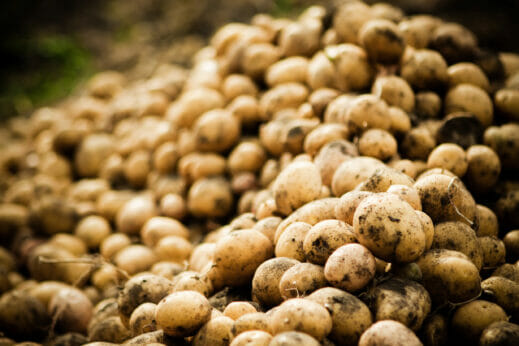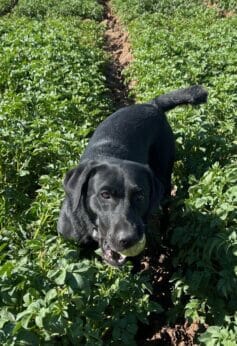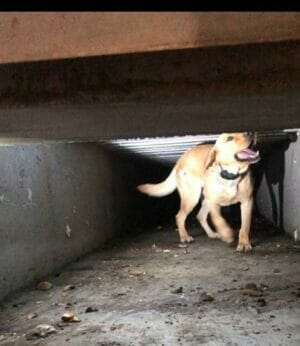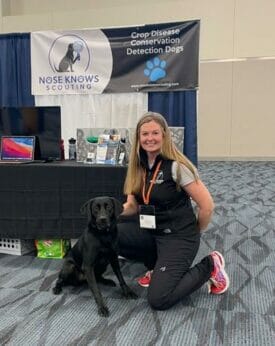Farmers and researchers are working to stem a devastating potato virus using what only a dog’s nose knows.

Andrea Parish holds back Zora, her black Labrador Retriever, who is coiled like a spring. Zora, a detection dog, can’t wait to get to those potatoes. Parish scans the environment for potential distractions—how noisy is it? Did the wind just change?—then releases Zora and watches her posture and ear and tail positions for cues. Zora goes from crate to crate, sniffing the tubers. Finally, Zora freezes, the final sign that tells Parish she has found the disease. Zora has earned her tennis ball and potentially saved a farmer thousands of dollars.
A dog’s nose is a wonder. While humans come equipped with about six million olfactory receptors, dogs have 300 million. As we use vision, they use scent. It’s hard to quantify, but estimates of how canine nose power compares to ours range from 10,000 times to a million times greater. As an example, dogs can discern substances as small as one part per trillion—that’s a single drop of liquid in 20 Olympic-sized swimming pools.
In addition to finding their pack, a mate or their next meal, dogs can detect heat, emotions, hormones and human diseases such as cancer, diabetes and COVID-19. But it’s not just human diseases that our canine companions can sniff out. The agriculture industry now knows dogs can also detect plant diseases such as Potato virus Y (PVY).
Spread by aphids, PVY plagues potato growers worldwide by reducing tuber yields and deforming potatoes. In Idaho, the country’s largest producer of potatoes, PVY is estimated to cost the state $34 million annually. The study calculated a loss in returns between $90 and $120 per acre with 10 percent PVY in the tubers.

Potato virus Y is a devastating disease that costs Idaho an estimated $34 million annually. (Photo: Shutterstock)
The typical test involves scooping an eye out of a mature tuber to be tested, sacrificing a percentage of healthy tubers. Andrea Parish’s team of four specialist Labrador Retrievers can flush out PVY in storage before the growing season begins or in the field without harming the tubers. Her firm Nose Knows Scouting travels the country assessing fields and crops and also accepts mail-order samples.
In 2019, Parish was training dogs in search-and-rescue and married to a potato crop consultant. She began to wonder why dogs weren’t helping track down crop diseases. “We have really high levels of PVY right now,” she says, “and if there is too much in, say, a proprietary variety, they’ll stop production of that variety, and it is shut down.”
Parish maintains that a dog’s nose is simply better than any technology we have. “The military uses bomb dogs after they tried everything else,” she says. “Every country has tried to replace bomb dogs’ noses, and what are they using? Dogs.”
A dog and handler gets certified on a scent, whether a bomb or a virus, as a team, requiring intensive training. Parish prefers not to train other scents to keep her dogs “accurate and ethical” on PVY.

Zora is one of the detection dog trained to sniff out PVY. (Photo courtesy of Andrea Parish)
She says when potato plants are small, her dogs can test 120 acres in two hours.
To further her training, she partnered with a career military and law enforcement dog trainer who certifies dogs worldwide in bomb and drug detection. She’s done more than one 80-week training session with several dogs now, focusing on PVY.
“I treat PVY as if it’s as important as finding a bomb,” she says, because it’s that devastating to a farm.
When a detector dog finds the chosen substance, it “indicates” with a trained behavior, such as sitting or freezing and pointing. Dogs are usually rewarded with a toy such as a tennis ball.
“You can train a scent pretty quickly,” says Parish. “Quickly” is relative: She notes that it takes approximately 12,000 repetitions of having them sniff the target odor, but training environment, athletic performance and reliability take much longer.
“It’s finding the dog that’s hard,” says Parish. “Dogs are really smart—they’ll take shortcuts. That is why daily training and testing is so important.” The dogs need constant reinforcement to stay sharp and intense physical exercise, which Parish says reinforces their detection abilities. Beyond scent drills in varied locations, they are up at 5:30 a.m. for walks and hit the treadmill daily.
Parish’s dogs have been trained to run through the air ducts (plenums) below storage bins to sniff out diseased tubers and walk conveyor belts to check seeds. For each environment, handlers must understand and predict how air flow, air pressure and temperature can affect the dog. And, of course, each dog has its own personality.
You need a dog that will stay focused despite physical or environmental distractions. Parish says she looks for the “one-percenters”—the ones driven by “the pure joy of working under any conditions; they live by their nose.”

A yellow lab runs through a plenum while sniffing for PVY. (Photo courtesy of Andrea Parish)
Borrowing the dog’s innate love for sniffing, called neophilia, Parish sees strong results. “I can now show up at any farm or university and they’ll give me a potato with PVY and the dog will hit it every time,” says Parish. “Everyone we have worked with has been very happy with us. We work with everyone from the breeding program to the processors.”
In one test, at North Dakota State University, Parish and Zora evaluated all of the NDSU potato breeding program’s germplasm, including 1,000 different genotypes, in less than a day.
“What we tested this morning with the dog would have taken us three months in the lab,” NDSU potato breeder Asunta (Susie) Thompson told NDSU’s agriculture department.
Testing like this could enable faster breeding, bringing new potato varieties to producers and the market sooner.
Parish is part of a two-year study with Montana State University’s seed certification program in winter and summer testing in which Zora is going “head to head” with current methods.
As part of the study, Nose Knows Scouting tested indoor tuber samples, and tubers flagged by Zora were then sent to Hawaii for testing for PVY. This summer, it is investigating a ¼-acre grow field with some known contaminated plants, and the dog’s results will be cross checked with visual inspections and lab test results.

Andrea Parish and Zora. (Photo courtesy of Andrea Parish)
Nina Zidack, director of the Seed Certification Program, has seen Parish and Zora in action with known contaminated samples.
“The dogs can absolutely smell PVY, there’s no doubt about it,” she said in a phone interview.
“The main thing we are looking at is how to use that as a tool; for instance, if a farmer could use that to rogue plants out of field or if they could use it to determine if a seed lot had PVY. Or, from a seed certification position, if we could ever use it as another test for PVY—I think that is less likely, but we are evaluating it.”
It seems humans are catching on to the myriad ways dogs’ unseen technology can help our society. Beyond potatoes, dogs are also helping detect disease in grapes, apples and citrus for the United States Department of Agriculture and in growing operations around the country often well before current methods—as well as pests such as Japanese beetles. In one USDA training exercise in Florida, dogs were 99 percent accurate on identifying citrus canker.
For industry-wide impact, Parish says she would like to see dogs used on a wider scale. “Having multiple handlers in multiple states, we could actually get rid of PVY. If we had enough handlers and dogs, we could sniff every potato out there.”
Been a dog lover lifelong ( i’m 80) its just another reason to love them